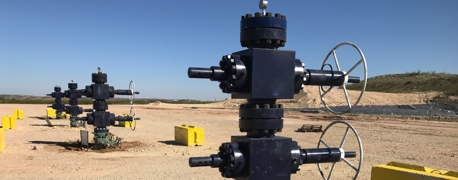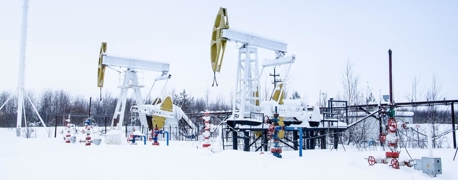Salt Domes: Where They Come From & What Hazards They Pose

A salt dome is a geological formation where natural salt deposits thousands of feet thick slowly push their way through layers of sediment toward the surface. This creates a large, dome-like structure crucial for the oil and gas industry.
What makes it crucial?
In a word: physics. As the salt dome pushes its way through the “overburden” (the sediment on top of it), rock layers tip upward, forming pockets up against the salt dome. These pockets collect oil and gas, forming large deposits available for drilling. As a result, the oil-and-gas industry is deeply invested in understanding accurately how and where salt domes form.
How Do Salt Domes Form?
Salt domes form through what geologists call diapirism. Evaporated water forms a layer of salt as thick as 2,000 to 5,000 feet, which isn’t distributed evenly. Small peaks in the salt layer cause sediment to gather more heavily in the valleys. Sediment gathering on the diapir (the peak) of salt slide further into the valleys, causing small peaks to become larger. Over millions of years, this results in the layers of sediment becoming separated by an enormous underground dome of salt.
Over time, the pressure of additional sediment pushes the salt dome upward until it breaches the surface. This sometimes form a sheet of salt called a “salt plug.” Geologists working in the oil-and-gas industry also find salt domes through co-occurring structures like natural gas vents.
Where Are Salt Domes in the US?
Due to the way that the North American continent formed millions of years ago, salt domes are mostly concentrated along the Gulf Coast. In fact, there are hundreds of salt domes spread in a massive arc across Texas and Louisiana. Much of Louisiana’s bayous are on top of enormous salt deposits, which is why its top exports include liquified natural gas and petroleum products.
What Salt Domes Are Used For
Salt dome properties mean they have multiple uses—sometimes multiple uses within the same cavern system! Salt domes provide rich deposits of oil and gas for extraction and massive quantities for salt to mine, but since 1977, the federal government has also used salt domes as storage facilities for federal energy reserves.
All of these uses, to one degree or another, require hollowing out the salt dome—typically with water. With multiple large-scale excavation projects happening at once in the same location, you’d expect each company to communicate with one another about where and how they’re excavating. This isn’t the case. In one salt dome-related disaster, two companies had hollowed out caverns less than 100 feet from one another. While hazardous, this wasn’t illegal at the time.
What Makes Salt Domes Dangerous
Salt domes can be anywhere from half a mile to five miles wide. Their depth can reach 10,000 feet or lower; there are even salt domes theoretically the same size as Mount Everest. The properties of salt domes—including their sheer size—demonstrate why companies seek permits to excavate in and around these massive formations.
But the continuous excavation of salt domes raises a serious question: what happens if excavation goes too far? What happens if a salt dome collapses?
There’s a few cases already where the collapse of a salt dome creates a massive sinkhole. These have largely occurred in Louisiana.
Bayou Corne Salt Dome Collapse
In 2012, a salt dome owned by Occidental Petroleum and operated by Texas Brine partially collapsed underneath Bayou Corne in Assumption Parish. Within two years, the sinkhole expanded from 2.5 acres to 26 acres—an order of magnitude larger. The collapse of a major cavern in the salt dome triggered a years-long evacuation order for the 350 residents within its diameter. Texas Brine initially paid residents a weekly stipend as compensation for its destruction of the local ecosystem and the massive release of oil and gas created by the sinkhole. Residents have remained in a legal battle with Texas Brine, Occidental Petroleum, and stone-mining company Vulcan for over a decade.
Lake Peigneur Drilling Disaster
Any discussion of salt dome disasters is incomplete without Lake Peigneur. In 1980, Lake Peigneur was a 10-foot deep freshwater lake primarily used for recreation. Today, it’s a brackish lake with a maximum depth of 200 feet, it is the deepest lake in Louisiana.
So what happened?
In November 1980, an oil rig contracted by Texaco was drilling just offshore of Jefferson Island, in the southeast portion of Lake Peigneur. Lake Peigneur was known to be sitting on top of a salt dome, and Jefferson Island itself was the result of the salt formation. However, regardless of prior knowledge, the night shift drillers ended up piercing into an inactive salt mine owned by Diamond Crystal Salt Company.
The tunnels of the salt mine were enormous: 100 feet by 80 feet, with pillars of salt holding up each level. Rushing water eroded these pillars, collapsing the tunnels and further exacerbating the erosion of the salt dome. The entire lakebed emptied so rapidly that a canal that flowed from the lake into Vermilion Bay reversed, drawing water from the Gulf of Mexico into the lake for the first time in recorded history.
By piercing a hole into a hollow part of the salt dome, the drilling company created a massive vortex.
This vortex was powerful enough to swallow the entire drilling rig, eleven barges, a tugboat, and 65 acres of land—including part of Jefferson Island. Miraculously, no humans were killed, although three dogs reportedly died in the vortex. Once the water pressure equalized, nine of the barges resurfaced. The other equipment is lost to the depths of the salt dome.
Salt Domes Present an Opportunity & a Responsibility
Salt domes have been an economic boon for centuries. First as salt mines, then as storage facilities and drilling opportunities. However, this level of economic usage comes with a responsibility: companies need to ensure they’re willing to cover the damage they cause if the dome collapses or leads to a disaster. Salt domes being as large as they are means any disaster could threaten people’s lives and livelihoods. Companies like Texas Brine, Occidental Petroleum, and Texaco need to be ready to take responsibility if they’re going to keep drilling deeper under our homes.
- Categories


